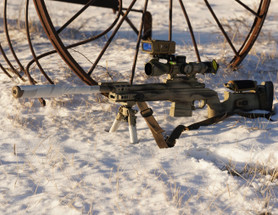Posted by WADE C. on Jul 20th 2025
WHAT IS THE PURPOSE OF A BIPOD?
What Is the Purpose of a Bipod?
Let’s start with the obvious: a bipod’s job is to hold your rifle up.
As the Harris bipod has done for decades, it props up the front end of your rifle so you can shoot, adjust, or — let’s be real — take a picture to post online for affirmation and fire emojis.
But if that’s all you’re asking of it, you're drastically underutilizing one of the most important tools on your rifle. With modern rifles, optics, and positional shooting techniques evolving rapidly, a bipod must do far more than just support weight. It should be a precision tool engineered for repeatable shooting, and most of what’s still bolted to rifles today fails that test.
The True Purpose of a Modern Bipod
A proper bipod:
-
Supports the front of the rifle
-
Adapts to field conditions
-
Deploys quickly
-
Returns to the same position and stance with every shot
-
Allows repeatable shooter input without binding the system
If your current bipod can’t do those things — or actively works against them — you’re compromising. And that compromise shows up on target, especially once you stretch distance or shoot beyond a flat, forgiving range bench.
Repeatability Starts With the Bipod, Not the Shooter
Most shooters believe repeatability is about doing the same thing behind the rifle every time. That’s true, but only half the story.
The bipod itself must allow for a repeatable mechanical interaction — especially under load.
That’s why I favor bipods like the Magpul and the MDT Ckye-Pod — they share one critical trait:
They allow a controlled amount of flex or “slop” that promotes mechanical consistency.
This “slop” isn’t sloppy engineering — it’s precision by design. It allows the shooter to:
-
Set the rifle down
-
Pull it into the shoulder
-
Lean into the bipod
...and rest into a repeatable wall of pressure every single time — without overdriving the rifle.
Why That Matters: From the Rifle’s Perspective
It’s not just about shooter consistency — it’s about how the rifle behaves during the firing cycle.
When a bipod doesn’t offer this engineered forgiveness, the shooter often ends up overloading the front end to "set" the rifle. That’s a problem for a few reasons:
-
Too much force flexes the forearm — especially in synthetic or chassis systems.
-
That flex can bind the action screws or recoil lug, introducing tension that changes how the action seats in the stock.
-
The result? First-round flyers, inconsistent groups, and erratic point of impact.
Rifles begin to move before the bullet leaves the barrel. In slow-motion footage, this becomes crystal clear. A rigid, unforgiving bipod without any engineered play makes this movement unpredictable. Now add spring-loaded legs — like the old-school Harris — and you introduce yet another variable: inconsistent reaction to inconsistent force.
You can't preload a bipod that fights you — and if you do, you're introducing instability instead of reducing it.
Boomer Disclaimer: Yes, We Hear You
Now I can already hear the boomers yelling at their screens:
"I can shoot a nat’s eye at 100 yards with my .308 and Harris bipod!"
No, you can’t.
And if that’s your benchmark for rifle performance, you might not be shooting far enough to even diagnose the problem.
More importantly, if you can’t shoot better than 1 MOA, which unfortunately describes a large percentage of rifle owners, you probably can’t shoot well enough to even detect these issues. And that’s not an insult — that’s an invitation.
I urge you to give this deeper thought and do some actual testing.
Next time you dry fire, or live fire a controlled group, pay close attention. Is your rifle jumping? Does your point of impact shift between groups or outings? Are you trying to force load and wondering why you can’t “get behind the rifle” consistently?
It might not be you.
It might be your bipod.
The Ongoing Test
We’ve been working behind the scenes on a comprehensive bipod feature breakdown. Every major model, tested the same way, in the same conditions, with detailed notes on:
-
Load behavior
-
Deployment time
-
Stability
-
Interface feel
-
Repeatability
But unlike YouTube gear reviews, we’re not calling something “best” after owning one model and using it twice. This kind of work takes serious time and money. We're not testing for affiliate clicks — we’re testing to understand, and eventually recommend, what's actually working in the field.
Truth is, there probably isn't one best bipod. The market continues to evolve, and use-case matters. But when we release our favorites list, it’ll come with hard-earned insight — not opinion.
Final Thoughts
A bipod should do more than hold your rifle up for a photo.
It should be part of your shooting system — one that enhances performance, not introduces new problems.
The best bipods let you build a stable, consistent position under real-world pressure. They return to the same stance every time. They don’t force tension into your chassis. And they allow you — the shooter — to focus on the shot, not the setup.
Look at your rifle. Does your bipod do all that? Or are you compromising?
If you're serious about precision, don’t settle for gear that looks good but works against you. Test it. Feel it. Pay attention.
And when you're ready, we'll be here to show you what works — and why.

